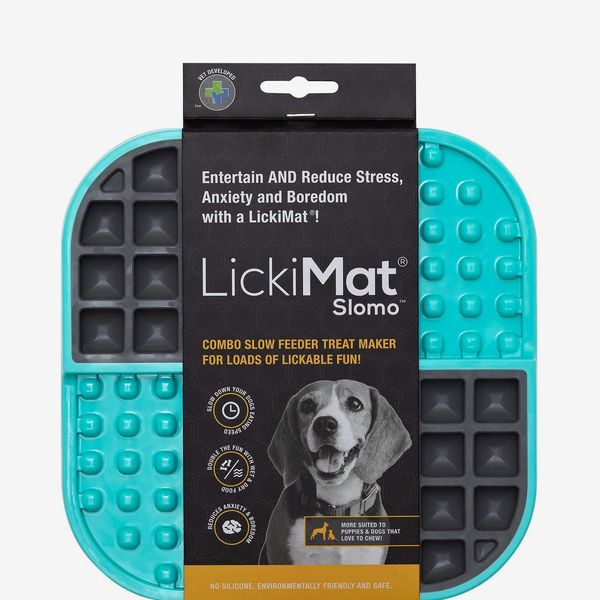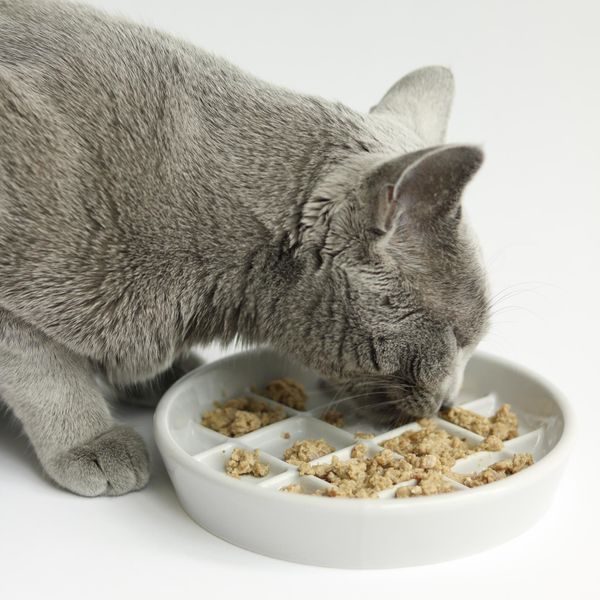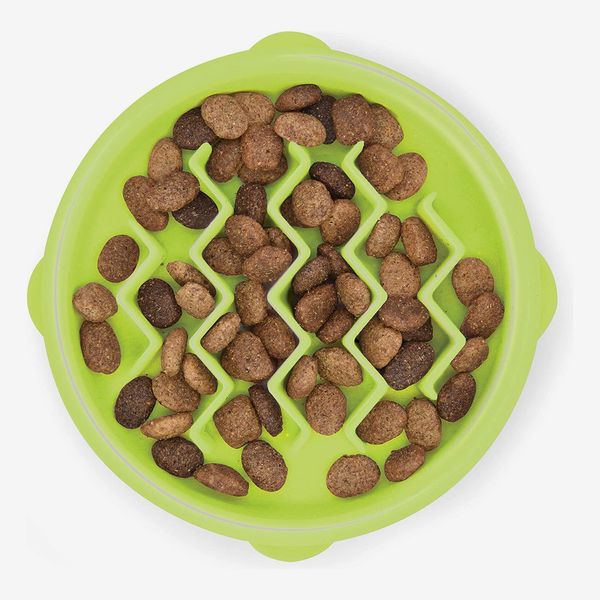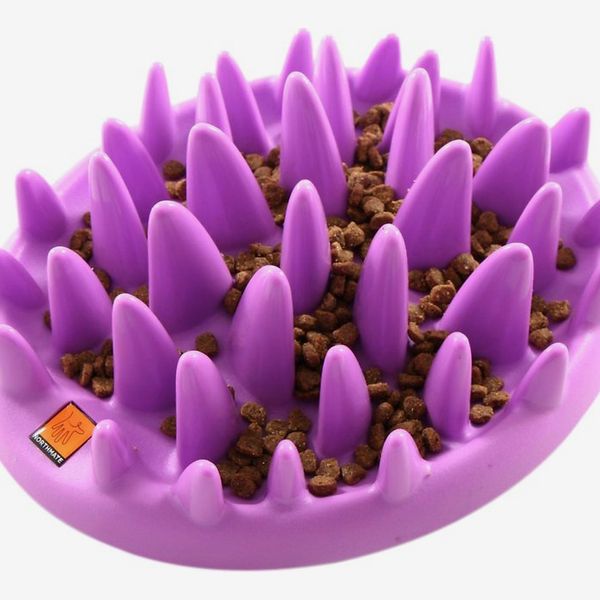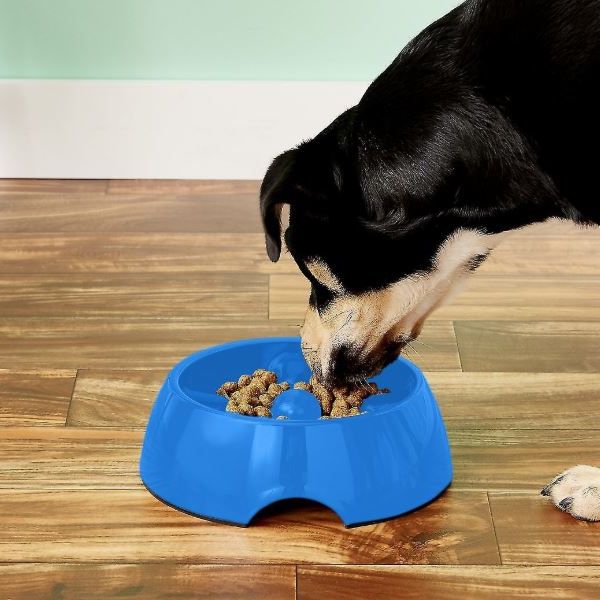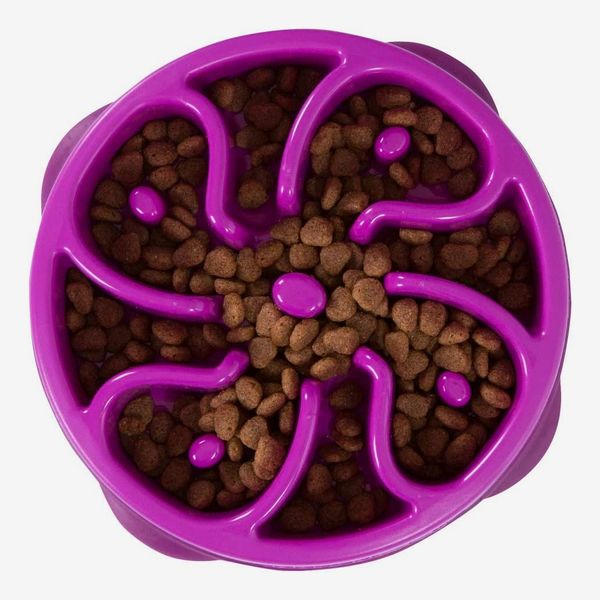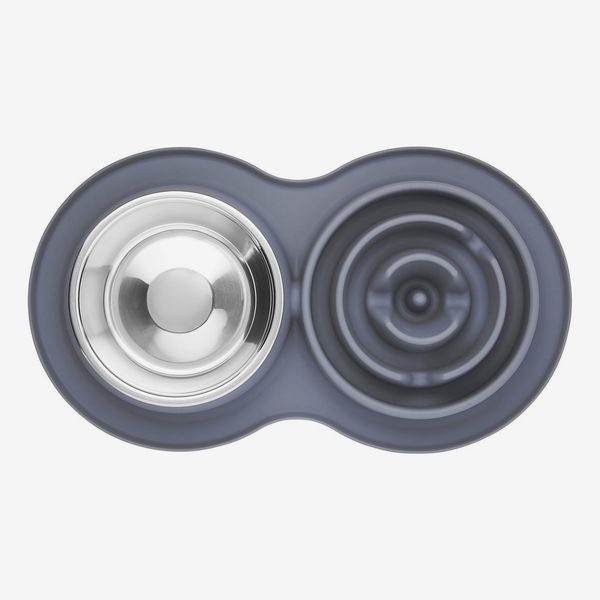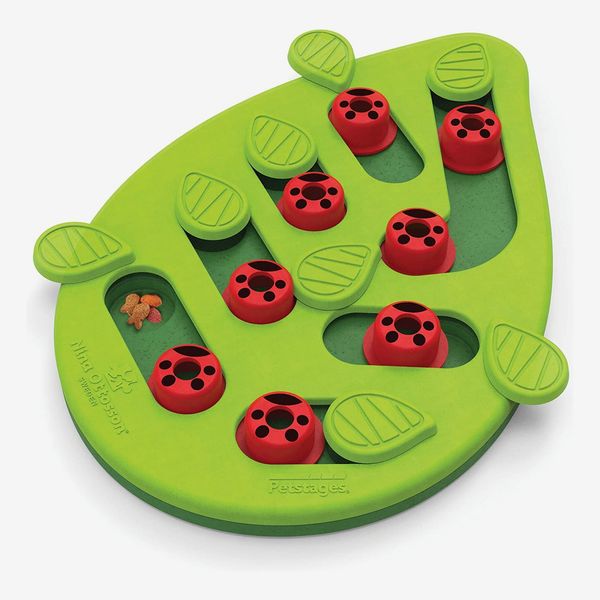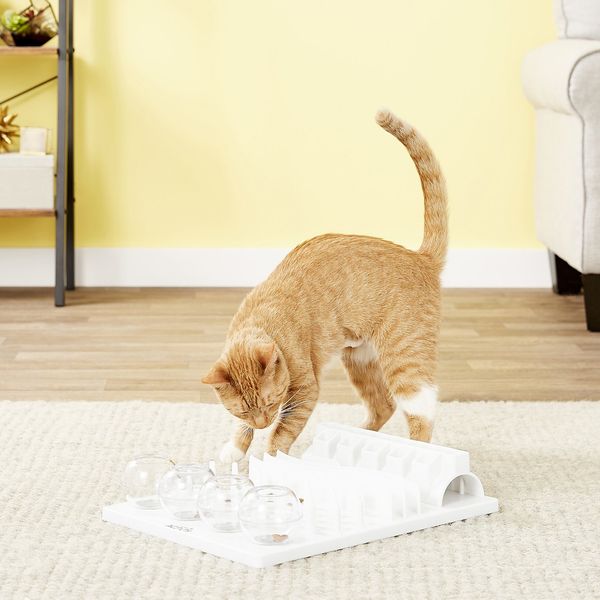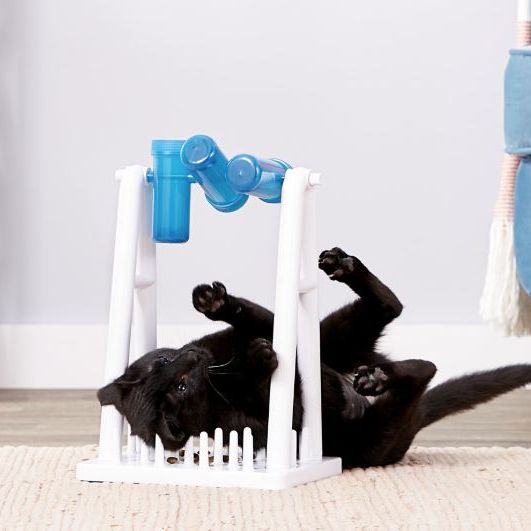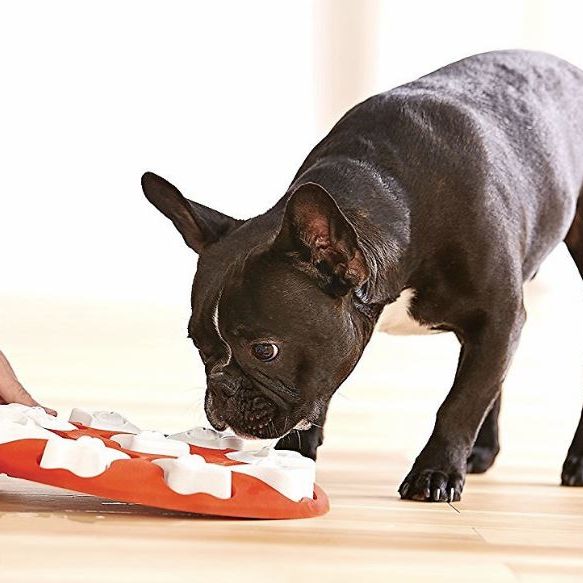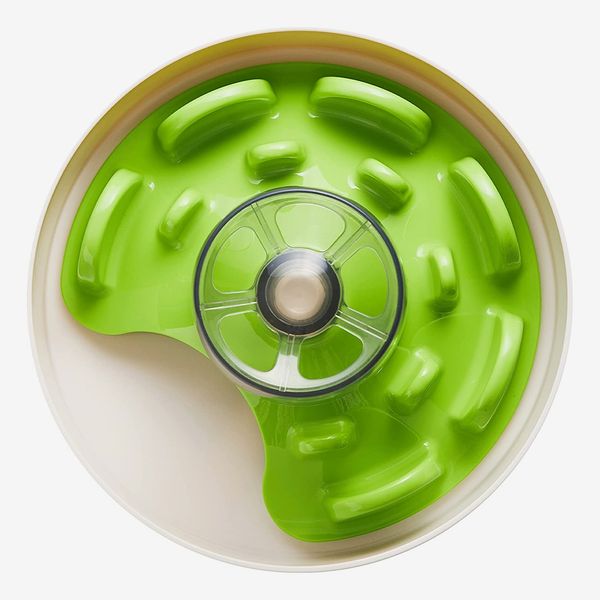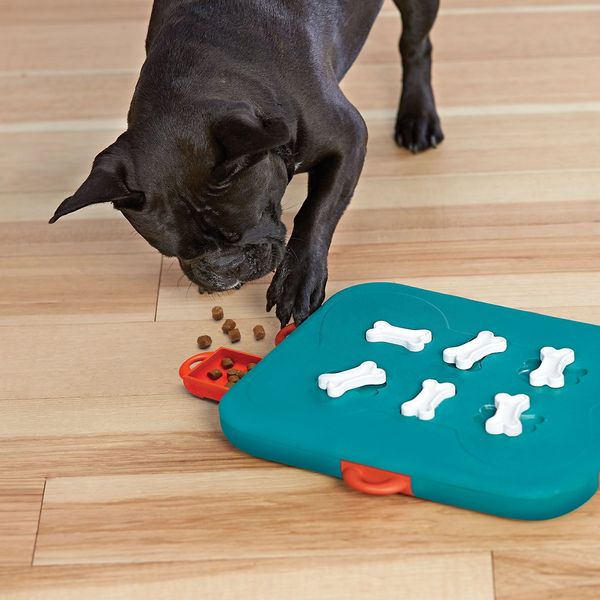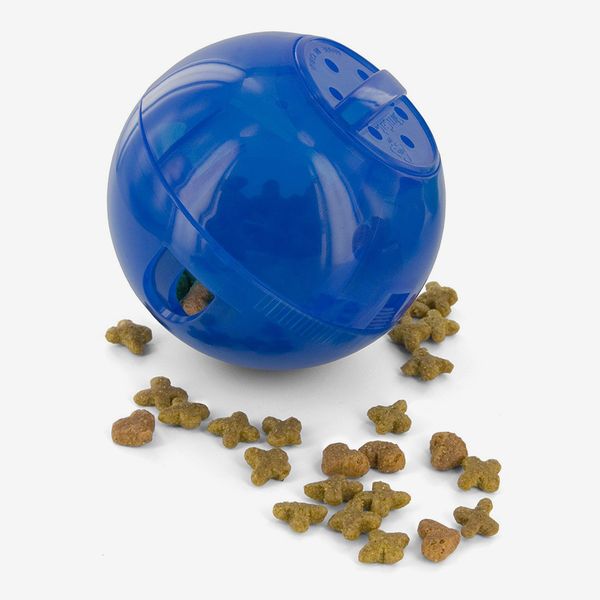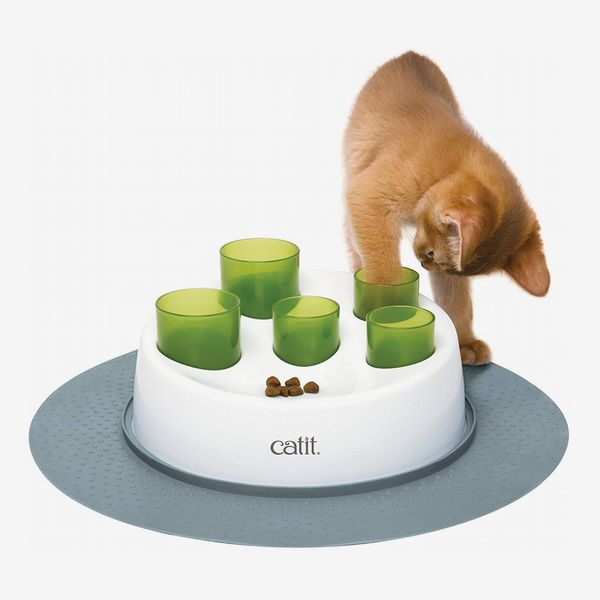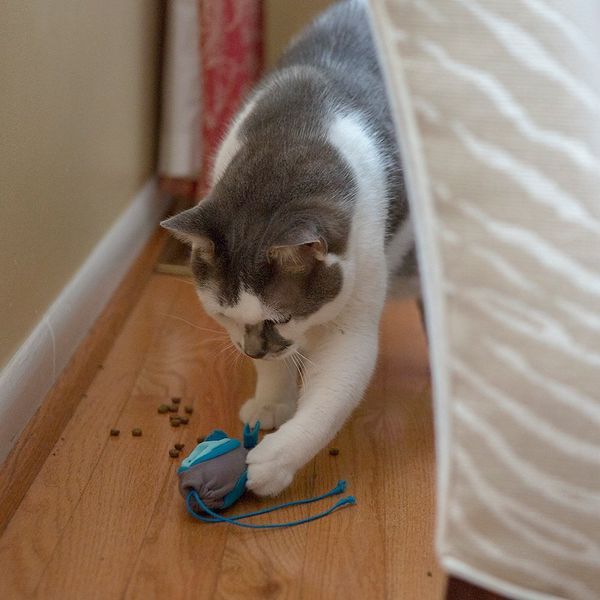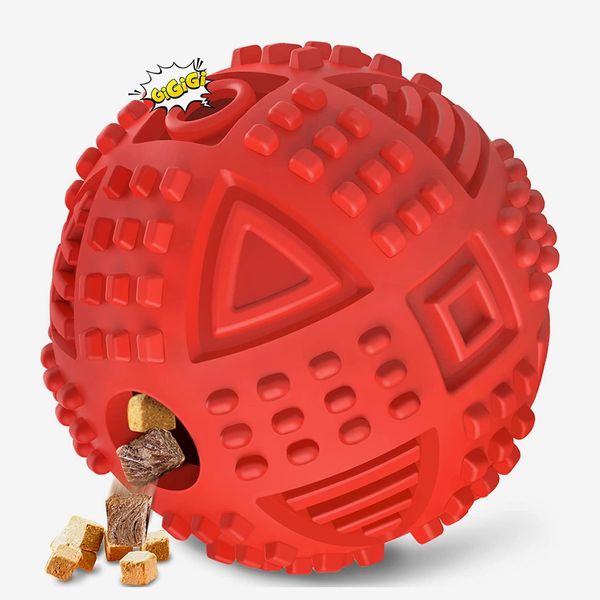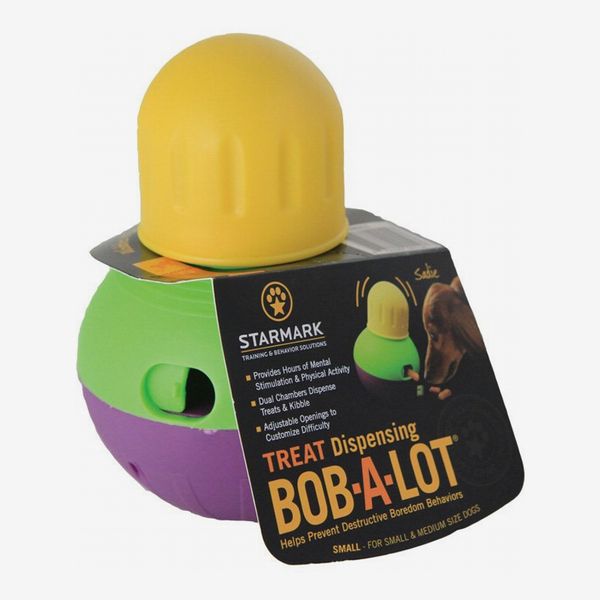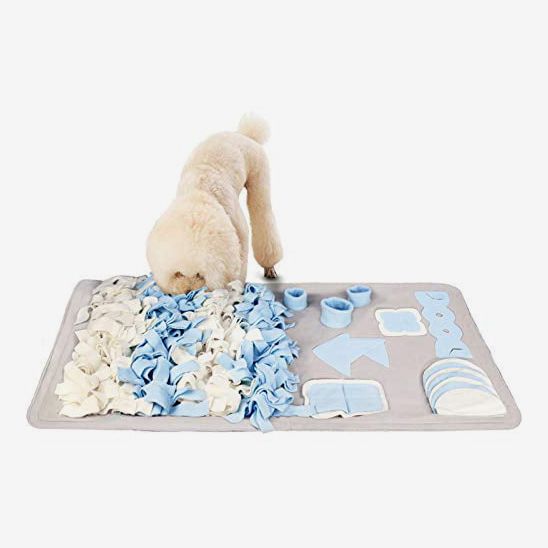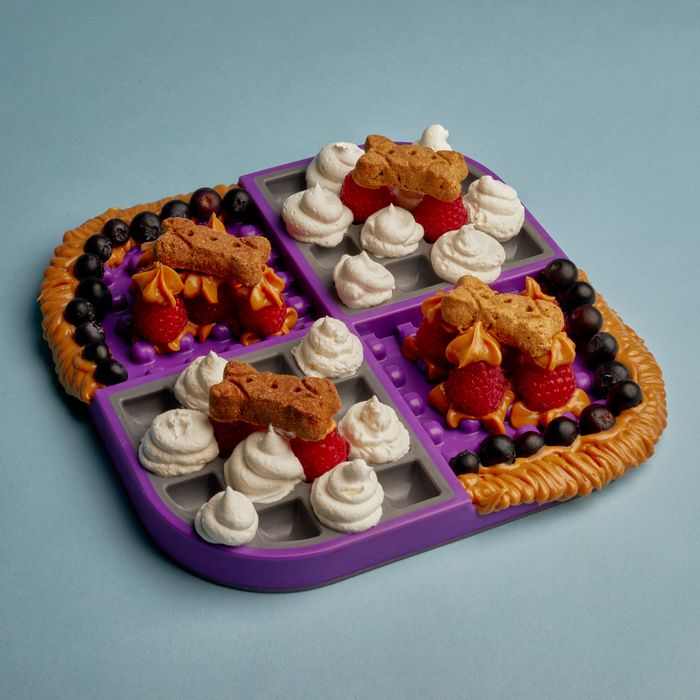
In this article
As much as we love to spoil our dogs and cats with toys, treats, and even fancy rain gear, the easy life of a domesticated pet can have its downfalls — especially when it comes to meals. “Dogs and cats are designed to spend hours each day working for their food,” says Dr. Jennifer Coates, a vet expert at Chewy. “We essentially take this job away from them when we provide them with food in bowls.” Along with causing your pet to gain weight if they’re overeating or not getting enough exercise, taking away the mental stimulation of hunting can cause behavioral issues that stem from boredom and separation anxiety.
To help solve these problems, veterinarians recommend puzzle feeders, which make pets work for their food by using their paws or noses to open a compartment, dig into a container, or navigate a maze. Dr. Zay Satchu, co-founder and chief veterinary officer of Bond Vet, says the key to introducing a puzzle feeder is to find a “really high-value treat” that your pet is willing to work hard for, then start with an easy puzzle that doesn’t require much problem solving. Dr. Ernie Ward, a veterinarian and the founder of the Association for Pet Obesity Prevention, says, “Start simple, and you will graduate up” to puzzles of increasing complexity. Both vets agree it’s also important to rotate the food puzzles you use so your pet doesn’t get bored with the same one.
We asked Coates, Satchu, Ward, and 12 other veterinarians, animal-behavior experts, and pet owners to share their favorite food puzzles for dogs and cats. Their recommendations for the best puzzle feeders, below, include puzzles of varying difficulty.
What we’re looking for
Feeder type
Puzzle food bowls can usually be classified as slow feeders, puzzle feeders, or hunting feeders. Slow feeders generally look like more complex versions of regular food bowls and, according to cat-behavior consultant Dr. Mikel Delgado, are mostly intended for cats and dogs who “eat too fast, maybe steal food from other pets, or ‘scarf and barf,’ as they say.” Since your pet has to work a little harder to get at their food, these puzzles will help prevent them from eating too much too quickly.
Puzzle feeders and hunting feeders are mostly designed to provide mental stimulation for your pet and activate their natural instincts, which may be underused if they’re just lounging around all day. Some puzzle feeders come equipped with moving parts your pet can interact with such as tubes, levers, or sliding compartments they must navigate to get their food. Hunting puzzles that are shaped like balls or mice can be batted around and pounced on, allowing your pet to practice chasing. “A big part of it is just keeping our pets occupied so they’re not bored and getting into trouble in other ways. It provides them with enrichment that can keep them happy and busy,” Dr. Delgado advises.
Food type
Before buying a puzzle bowl, think about what kind of food or treats your pet responds to best and will be the most motivated to work for. Most feeders will work fine with dry kibble; if your pet prefers wet food, however, it’s best to look for a feeder that’s easy to clean and won’t make too much of a mess. There are also feeders designed for special treats such as peanut butter or catnip.
Material
The material a feeder is made of affects what type of food it’s compatible with and how easy it is to clean. Plastic and ceramic feeders can work with both dry and wet food, and some may even be dishwasher safe, while a feeder made of cardboard or soft fabric will only work with dry food or treats. You should also consider the feeder’s durability; if your pet has a tendency to play rough, you may want a feeder made of hardier materials such as rubber.
Best puzzle feeder for cats and dogs overall
Feeder type: Grooved slow feeder | Food type: Wet and dry food | Material: Rubber
The LickiMat is a tried-and-true option that comes recommended by multiple experts. It’s suitable for both cats and dogs; its fairly uncomplicated grooved design works with both dry and wet chow and won’t make a mess of your floors, and its rubber material is durable and easy to clean, so it will last for years. “It slows them down and gets them physically involved because it’ll move and they can pull it around, but it won’t smear food all over your house,” says Kerrie McKeon, resident cat expert at the animal-welfare-and-adoption organization Bideawee. The licking motion can also soothe your pet, according to Kate Benjamin, founder of the stylish cat-gear website Hauspanther. “They were originally designed for hyper dogs to lick peanut butter off, but cats like it too,” Benjamin says. “There’s something about it that calms them when they have to work at licking this food off.”
When Strategist writer Arielle Avila bought one for her dog, Maggie, she reported that Maggie “licked for 15 minutes straight, not even looking up to bark at squirrels scurrying past our window.” The mat’s simplicity is “exactly what makes it work,” Avila writes. “It doesn’t require any searches or problem-solving.” So while you may eventually want to graduate to more involved feeders, starting your pet off with the Lickimat is a great way to introduce them to puzzle feeders and keep them engaged and entertained for long stretches of time.
Best easy slow feeder for cats
Feeder type: Ridged slow feeder | Food type: Wet and dry food | Material: Porcelain
This thoughtfully designed slow feeder can hold both wet and dry food and resembles a waffle with its ridged grid, which creates a barrier to slow down rapid eating. Its wide, shallow design is adapted for cats because “cats don’t like their whiskers hitting the edge of the bowl,” says McKeon. “If they have to stick their face too far down into something, they might just walk away.” But this bowl is just the right size for cats to dine without any whisker disturbance — and is aesthetically appealing too, not to mention dishwasher safe. Strategist senior editor Jen Trolio tested this bowl with one of her two cats who is notorious for eating too fast, then stealing extra food from his slower-paced brother (he also often throws up on the rug). Trolio uses the bowl with wet cat food and says it slows down the speed racer enough that both cats now finish their meal at about the same time. She especially likes it for its ceramic material, “which looks so much nicer than plastic or silicone.”
Best intermediate slow feeder for cats
Feeder type: Ridged slow feeder | Food type: Wet and dry food | Material: Plastic
Dr. Janet Cutler, a certified cat behaviorist at Cat World, says this Petstages bowl provides a moderate difficulty level “and is a great option to begin your puzzle-feeding journey with a cat.” The raised zigzag edges are high enough to pose more of a challenge than the shallower bowl above, but once your cat has figured out how to work around the ridges, they shouldn’t have too much difficulty.
Best advanced slow feeder for cats
Feeder type: Spiked slow feeder | Food type: Dry food | Material: Plastic
This feeder is designed with grasslike plastic spikes, forcing cats to maneuver around the obstacles to find scattered treats or kibble. Delgado is a fan, and so is Nikki Naser, a pet expert at Chewy, who says, “The tall spikes will add to the challenge — mentally and physically — as your kitty tries to push the pieces through to earn her dinner.”
Best easy slow feeder for dogs
Feeder type: Ridged slow feeder | Food type: Wet and dry food | Material: Plastic
For a dog new to food puzzles, nearly all our experts suggest a bowl that is divided by ridges so it’s slightly more difficult to eat from than a regular bowl. “It’s a way to slow them down while they eat,” says Satchu, “but it also triggers their mind to think through How am I going to get this little piece of kibble from the very depths of this bowl when my tongue can’t just scoop it up?” Naser likes this one from Dogit because “the nonslip rubber keeps dogs from scooting the bowl around, but the cutout at the bottom makes it easy for you to pick it up off the floor.”
Best intermediate slow feeder for dogs
Feeder type: Flower slow feeder | Food type: Wet and dry food | Material: Plastic
You can also try a bowl that is divided into shapes or patterns, like this fun flower-shaped option. Ward says these kinds of bowls are still “pretty easy” for pets, because once they figure it out, they can “go in with their muzzle and actually eat their meal.” Naser adds that dogs will “eat up to ten times slower with these.”
Best advanced slow feeder for dogs
Feeder type: Maze slow feeder | Food type: Wet and dry food | Material: Silicone and stainless steel
“As your dog starts to get more accustomed to slow feeders, you can increase the intricacy of the mazes and narrowness of the wells,” advises Kate Karam, a pet expert at Chewy. The concentric rings of this Frisco slow feeder are fairly close together, which means your pup will really have to work to get at the food nestled in between. It also includes a stainless steel water bowl, which encourages “eating and drinking at the same time, so they’re going to get fuller faster,” says Karam.
Best easy puzzle feeder for cats
Feeder type: Swivel puzzle feeder | Food type: Treats and dry food | Material: Wood plastic composite
Cutler loves this Nina Ottoson ladybug puzzle feeder, both because it’s adorable and because it has adjustable difficulty levels. For cats who are new to puzzle feeders, you can start by simply placing kibble into the compartments and leaving it out in the open; once they’ve grown comfortable eating from the feeder, you can adjust the slides and pegs to increase the challenge. “This allows for a couple different activities in cats, in that they need to paw at the leaves to move them, and then lift the kibble or treats out of the compartments,” Cutler says.
Best intermediate puzzle feeder for cats
Feeder type: Variety puzzle feeder | Food type: Treats and dry food | Material: Plastic
With a variety of different puzzles — a tunnel, fish bowl–like pods, and a squiggly path — this mat offers cats lots of challenging ways to work for their food. “Cats typically like to hunt for things,” says Satchu, “so this allows them the opportunity to use their paws and their noses,” to dig food out of the various compartments. Delgado agrees it’s good for keeping cats mentally stimulated. “The versatility means different types of problems to solve,” she says.
Best advanced puzzle feeder for cats
Feeder type: Interactive tube puzzle feeder | Food type: Treats and dry food | Material: Plastic
This toy includes tubes that hold cat treats, but since they have a narrow opening and swing back and forth, cats have to figure out how to turn them upside down to spill out the food. And once the treats are out of the tubes, they fall onto a spiky surface that cats then have to navigate with their paws. It’s one of Delgado’s top picks for an advanced cat puzzle.
Best easy puzzle feeder for dogs
Feeder type: Hidden compartment puzzle feeder | Food type: Treats and dry food | Material: Plastic
According to Ward, Swedish dog trainer Nina Ottosson is “a pioneer” in the world of puzzle feeders, and most of the experts we spoke to mentioned at least one of her products, which are ranked according to three levels of difficulty. This level-one puzzle, which makes dogs lift bone-shaped pieces to reveal food in hidden compartments, comes recommended by Delgado.
Best intermediate puzzle feeder for dogs
Feeder type: Spinning puzzle feeder | Food type: Treats and dry food | Material: Plastic
Karam says this spinning feeder is a good example of a fairly tricky puzzle “because your dog has to do a lot. You put the food into the center well, and as it spins, the food begins to land on the maze, and some of it lands underneath in the bowl.” She suggests giving this puzzle to an older dog “that enjoys taking their time with this kind of challenge,” rather than an impatient puppy.
Best advanced puzzle feeder for dogs
Feeder type: Locking-drawer puzzle feeder | Food type: Treats and dry food | Material: Plastic
Puzzles that include multiple steps are generally more challenging; that’s certainly true of Nina Ottosson’s level-three puzzles, which “are a lot more difficult, requiring our dogs to do different things to get the prize,” says Nicole Ellis, an expert dog trainer at Rover. This level-three toy is one of the most advanced available, as dogs need to first unlock a series of drawers by twisting the bones on top and then pull the drawers open to access their food.
Best easy hunting feeder for cats
Feeder type: Ball hunting feeder | Food type: Treats and dry food | Material: Plastic
Recommended by Satchu and Delgado, this SlimCat ball has small holes that dispense treats when cats roll it around. Delgado likes that the SlimCat is adjustable so it can adapt as cats learn how to use it. She says, “You can make it easier with larger holes or more challenging by making the holes for the food smaller, which means more interactions are needed to get the food out.”
Best intermediate hunting feeder for cats
Feeder type: Digger hunting feeder | Food type: Treats and dry food | Material: Plastic
The Catit digger is a favorite of both Karam and Kingsgate Animal Hospital veterinarian Dr. Jamie Whittenburg; Whittenburg deems it a level more challenging than the ball feeder since it moves “a bit more erratically” but is still fairly straightforward for your cat to interact with. Karam calls it “absolutely genius” for the way it activates a cat’s natural hunting instincts: “If you’ve ever watched your cat work for hours to get something out of a hole in your yard, they’ll just dig forever,” she says. However, since the feeder could potentially frustrate a hungry kitty, Karam suggests keeping a close eye on your cat “to make sure they’re not freaking out to the point of just tipping it over.”
Best advanced hunting feeder for cats
Feeder type: Mice hunting feeder | Food type: Treats and dry food | Material: Plastic and fabric
This kit includes three mouse-shaped toys you can fill with food and hide around the house for cats to sniff out. Ellis says she loves that it has “toy mice for your cat to bat and pounce at to get their food, something they naturally love to do,” and Ward likes that the mice “engage your cat’s inner predator.” Naser says it gives cats “the satisfaction of finding the mice around the house, batting around their prey to release the food, and finally feasting on their catch.”
Best easy hunting feeder for dogs
Feeder type: Ball hunting feeder | Food type: Dry food, wet food, and treats | Material: Rubber
This spherical dog toy works the same way as the PetSafe cat hunting feeder, above, but is made out of more durable rubber for dogs that tend to play rougher. Satchu is a fan and suggests filling one with food and water and then freezing it to make a “dog Popsicle” as a treat on a hot day.
Best intermediate hunting feeder for dogs
Feeder type: Ball hunting feeder | Food type: Dry food, wet food, and treats | Material: Plastic
Dog trainer Julie Burgess uses this StarMark toy with her clients’ dogs and has heard tons of positive feedback about it. Since it has weights in the bottom, it will bob back and forth when nudged but always return to an upright and “ready for action” position, Burgess explains. It comes in two different sizes, to accommodate both small and large breeds, and the difficulty level can be adjusted via the “gate” at the bottom. Just note that Karam cautions against making the opening too small or you could risk disincentivizing your pup: “One little treat is not gonna make your dog happy,” she says, adding that they’ll need enough of a reward to ensure their effort is worth it.
Best advanced hunting feeder for dogs
Feeder type: Mat hunting feeder | Food type: Dry food and treats | Material: Fleece fabric
This snuffle mat mimics the way dogs would hunt in nature by encouraging their instincts to forage and root around in the ground. It was recommended to Strategist junior writer Brenley Goertzen by an obedience trainer at puppy school, and Goertzen reports that her Australian Shepard mix “loves sniffing around for treats or dry food.” Since it’s made from a soft fleece fabric and not hard plastic, it “can’t scuff or scratch your floors” and you can just “pop it in the washer and dryer” for easy cleaning. It’s also suitable for all breeds, both large and small; Goertzen’s parents found the mat to be a better choice for their Great Dane since he’s “so big that he can flip over most plastic puzzle feeders with one paw.”
Our experts
• Arielle Avila, Strategist writer
• Kate Benjamin, founder of cat-gear website Hauspanther
• Julie Burgess, veterinary technician and dog trainer at Senior Tail Waggers
• Jennifer Coates, vet expert at Chewy
• Dr. Janet Cutler, certified cat behaviorist at Cat World
• Dr. Mikel Delgado, cat-behavior consultant
• Nicole Ellis, expert dog trainer at Rover
• Brenley Goertzen, Strategist junior writer
• Kate Karam, pet expert at Chewy
• Kerrie McKeon, resident cat expert at animal-welfare-and-adoption organization Bideawee
• Nikki Naser, pet expert at Chewy
• Dr. Zay Satchu, co-founder and chief veterinary officer of Bond Vet
• Jen Trolio, Strategist senior editor
• Dr. Ernie Ward, veterinarian and the founder of the Association for Pet Obesity Prevention
• Dr. Jamie Whittenburg, veterinarian director at Kingsgate Animal Hospital
Additional reporting by Karen Iorio Adelson
The Strategist is designed to surface the most useful, expert recommendations for things to buy across the vast e-commerce landscape. Some of our latest conquests include the best acne treatments, rolling luggage, pillows for side sleepers, natural anxiety remedies, and bath towels. We update links when possible, but note that deals can expire and all prices are subject to change.

